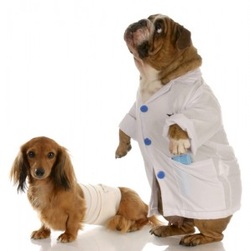Dog cruciate problems are known for affecting older dogs, but younger dogs can also have problems - especially when they are overweight, inactive or hyperactive. This condition begins as a small tear in the dog’s cruciate ligament (dog ACL), and if undetected will lead to a full rupture of the cruciate, dog arthritis and cartilage (meniscus) complications.
Early detection through regular check-ups and prompt intervention is the best way of stopping the progression of this condition.
Inside the dog’s knee joint are the two cruciate ligaments that stabilize the knee and prevent it from twisting too far in any direction. If once these ligaments get ruptured, it will create pain, dog arthritis and poor stability of the knee. This can happen in two ways, the gradual degeneration or traumatic injuries.
What is a gradual degeneration? It is when the cruciate ligament weakens as a result of the dog’s age and the constant movement of the knees can cause the wear and tear of the ligaments for pups.
On traumatic injuries, the torn ligament usually occur after traumatic injury which can be seen in very active dogs, varied breeds and most especially those dogs that are constantly jumping and twisting.
At the bottom of the knee are the meniscal cartilages that serve as the shock absorbers for the joint in movement. Using the damaged knee can worsen the tear in the cartilage or meniscus causing severe pain. At the beginning, your dog may show mild lameness - just not weight bearing when standing. However the progression of dog arthritis can lead to intolerable pain and can ruin a dog’s life. Symptoms can include lameness, pain in the knee, joint swelling and atrophy (shrinking of the muscles).
Hence the treatment is by surgery and the goal is to stabilize the knee and slow, or if possible, stop the dog arthritis.
Some of our canine friends are not suitable for surgery and may be treated with a combination of different treatments such as exercise restriction, anti-inflammatory medications, weight-loss and physical therapy. Most small dogs will regain their normal movement without the need for surgery, but will develop severe dog arthritis in later years.
Dogs with arthritis are similar to humans and will need the same tender loving care after surgery that we would expect for ourselves.
Dog Cruciate Surgery Complications (PDF)
Early detection through regular check-ups and prompt intervention is the best way of stopping the progression of this condition.
Inside the dog’s knee joint are the two cruciate ligaments that stabilize the knee and prevent it from twisting too far in any direction. If once these ligaments get ruptured, it will create pain, dog arthritis and poor stability of the knee. This can happen in two ways, the gradual degeneration or traumatic injuries.
What is a gradual degeneration? It is when the cruciate ligament weakens as a result of the dog’s age and the constant movement of the knees can cause the wear and tear of the ligaments for pups.
On traumatic injuries, the torn ligament usually occur after traumatic injury which can be seen in very active dogs, varied breeds and most especially those dogs that are constantly jumping and twisting.
At the bottom of the knee are the meniscal cartilages that serve as the shock absorbers for the joint in movement. Using the damaged knee can worsen the tear in the cartilage or meniscus causing severe pain. At the beginning, your dog may show mild lameness - just not weight bearing when standing. However the progression of dog arthritis can lead to intolerable pain and can ruin a dog’s life. Symptoms can include lameness, pain in the knee, joint swelling and atrophy (shrinking of the muscles).
Hence the treatment is by surgery and the goal is to stabilize the knee and slow, or if possible, stop the dog arthritis.
Some of our canine friends are not suitable for surgery and may be treated with a combination of different treatments such as exercise restriction, anti-inflammatory medications, weight-loss and physical therapy. Most small dogs will regain their normal movement without the need for surgery, but will develop severe dog arthritis in later years.
Dogs with arthritis are similar to humans and will need the same tender loving care after surgery that we would expect for ourselves.
Dog Cruciate Surgery Complications (PDF)

 RSS Feed
RSS Feed